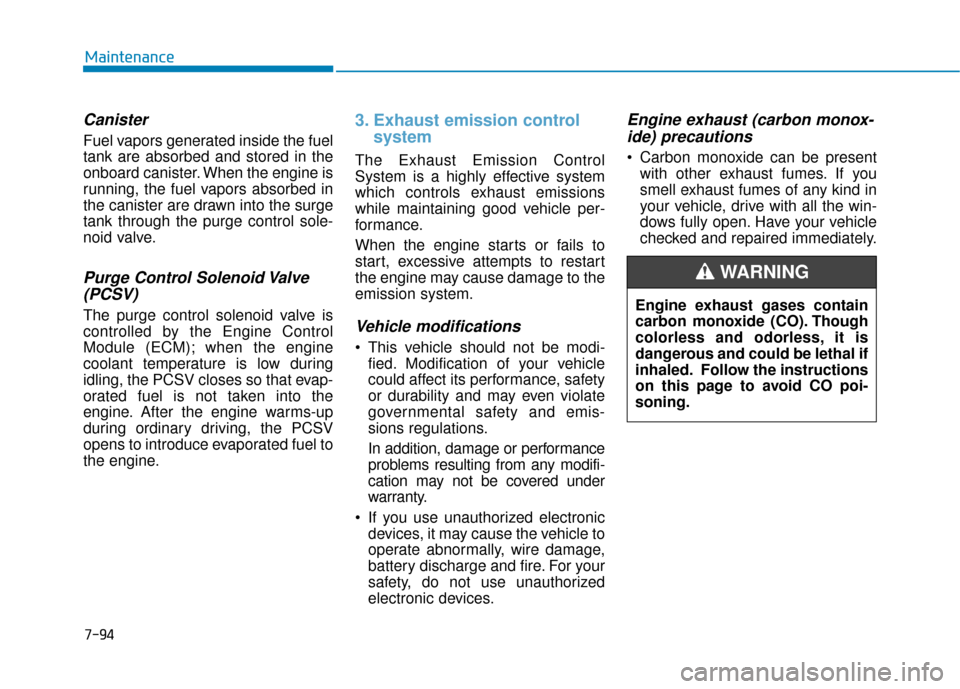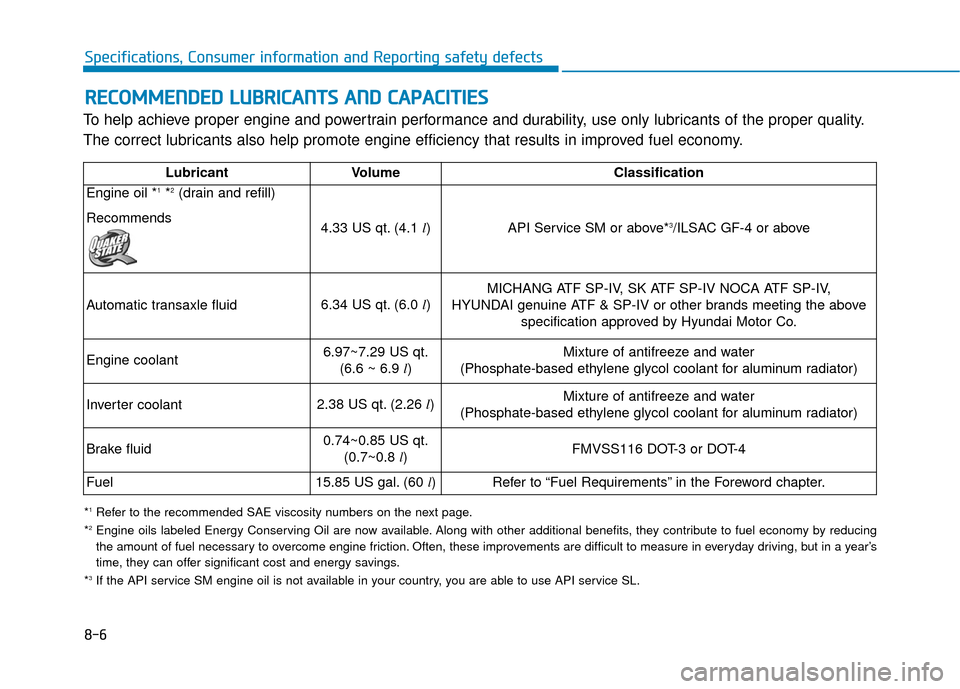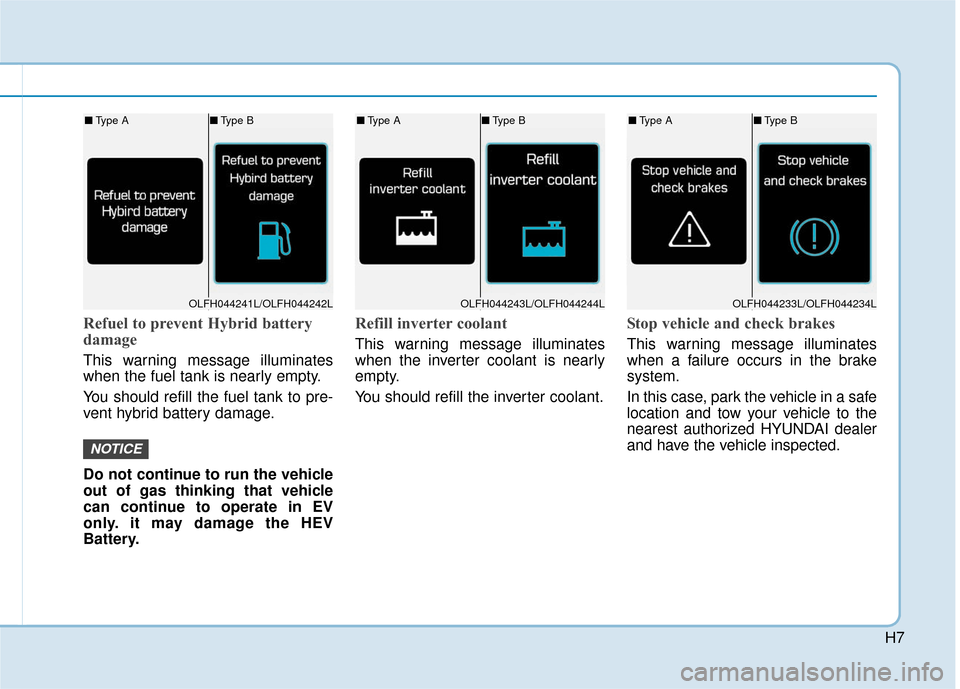2016 Hyundai Sonata Hybrid coolant
[x] Cancel search: coolantPage 618 of 708

7-54
Maintenance
Tire terminology and defini-
tions
Air Pressure
The amount of air inside the tire
pressing outward on the tire. Air
pressure is expressed in pounds per
square inch (psi) or kilopascal (kPa).
Accessory Weight
This means the combined weight of
optional accessories. Some exam-
ples of optional accessories are
automatic transaxle, power seats,
and air conditioning.
Aspect Ratio
The relationship of a tire’s height to
its width.
Belt
A rubber coated layer of cords that is
located between the plies and the
tread. Cords may be made from steel
or other reinforcing materials.
Bead
The tire bead contains steel wires
wrapped by steel cords that hold the
tire onto the rim.
Bias Ply Tire
A pneumatic tire in which the plies
are laid at alternate angles less than
90 degrees to the centerline of the
tread.
Cold Tire Pressure
The amount of air pressure in a tire,
measured in pounds per square inch
(psi) or kilopascals (kPa) before a tire
has built up heat from driving.
Curb Weight
This means the weight of a motor
vehicle with standard and optional
equipment including the maximum
capacity of fuel, oil and coolant, but
without passengers and cargo.
DOT Markings
A code molded into the sidewall of a
tire signifying that the tire is in com-
pliance with the U.S. Department of
Transportation motor vehicle safety
standards. The DOT code includes
the Tire Identification Number (TIN),
an alphanumeric designator which
can also identify the tire manufactur-
er, production plant, brand and date
of production.
GVWR
Gross Vehicle Weight Rating
GAWR FRT
Gross Axle Weight Rating for the
Front Axle.
GAWR RR
Gross Axle Weight Rating for the
Rear axle.
Page 658 of 708

7-94
Maintenance
Canister
Fuel vapors generated inside the fuel
tank are absorbed and stored in the
onboard canister. When the engine is
running, the fuel vapors absorbed in
the canister are drawn into the surge
tank through the purge control sole-
noid valve.
Purge Control Solenoid Valve(PCSV)
The purge control solenoid valve is
controlled by the Engine Control
Module (ECM); when the engine
coolant temperature is low during
idling, the PCSV closes so that evap-
orated fuel is not taken into the
engine. After the engine warms-up
during ordinary driving, the PCSV
opens to introduce evaporated fuel to
the engine.
3. Exhaust emission control system
The Exhaust Emission Control
System is a highly effective system
which controls exhaust emissions
while maintaining good vehicle per-
formance.
When the engine starts or fails to
start, excessive attempts to restart
the engine may cause damage to the
emission system.
Vehicle modifications
This vehicle should not be modi-
fied. Modification of your vehicle
could affect its performance, safety
or durability and may even violate
governmental safety and emis-
sions regulations.
In addition, damage or performance
problems resulting from any modifi-
cation may not be covered under
warranty.
If you use unauthorized electronic devices, it may cause the vehicle to
operate abnormally, wire damage,
battery discharge and fire. For your
safety, do not use unauthorized
electronic devices.
Engine exhaust (carbon monox-ide) precautions
Carbon monoxide can be present
with other exhaust fumes. If you
smell exhaust fumes of any kind in
your vehicle, drive with all the win-
dows fully open. Have your vehicle
checked and repaired immediately.
Engine exhaust gases contain
carbon monoxide (CO). Though
colorless and odorless, it is
dangerous and could be lethal if
inhaled. Follow the instructions
on this page to avoid CO poi-
soning.
WARNING
Page 667 of 708

8-6
Specifications, Consumer information and Reporting safety defects
To help achieve proper engine and powertrain performance and durability, use only lubricants of the proper quality.
The correct lubricants also help promote engine efficiency that results in improved fuel economy.
R R E
EC
CO
O M
M M
ME
EN
N D
DE
ED
D
L
L U
U B
BR
RI
IC
C A
A N
N T
TS
S
A
A N
N D
D
C
C A
A P
PA
A C
CI
IT
T I
IE
E S
S
*1Refer to the recommended SAE viscosity numbers on the next page.
*2Engine oils labeled Energy Conserving Oil are now available. Along with other additional benefits, they contribute to fuel econo my by reducing
the amount of fuel necessary to overcome engine friction. Often, these improvements are difficult to measure in everyday driving, but in a year’s
time, they can offer significant cost and energy savings.
*
3If the API service SM engine oil is not available in your country, you are able to use API service SL.
LubricantVolume Classification
Engine oil *
1*2(drain and refill)
Recommends
4.33 US qt. (4.1 l)
API Service SM or above*3/ILSAC GF-4 or above
Automatic transaxle fluid
6.34 US qt. (6.0 l)MICHANG ATF SP-IV, SK ATF SP-IV NOCA ATF SP-IV,
HYUNDAI genuine ATF & SP-IV or other brands meeting the above specification approved by Hyundai Motor Co.
Engine coolant6.97~7.29 US qt.(6.6 ~ 6.9 l)Mixture of antifreeze and water
(Phosphate-based ethylene glycol coolant for aluminum radiator)
Inverter coolant
2.38 US qt. (2.26 l) Mixture of antifreeze and water
(Phosphate-based ethylene glycol coolant for aluminum radiator)
Brake fluid
0.74~0.85 US qt. (0.7~0.8 l) FMVSS116 DOT-3 or DOT-4
Fuel15.85 US gal. (60 l)Refer to “Fuel Requirements” in the Foreword chapter.
Page 676 of 708

I-4
Clothes hanger ..............................................................3-151
Combined instrument, see instrument cluster ................3-57
Consumer information ......................................................8-9
Coolant ........................................................................\
....7-29
Cooling fluid, see engine coolant ...................................7-29
Cruise control..................................................................5-43
Cup holder.....................................................................3-1\
47
Dashboard illumination, see instrument panel illumination..................................................................3-58
Dashboard, see instrument cluster ..................................3-57
Day/night rearview mirror ..............................................3-19
Daytime running light ...................................................3-114
Defogging (Windshield) ...............................................3-141
Defroster (Rear window) ..............................................3-126
Defrosting (Windshield) ...............................................3-141
Digital speedometer ......................................................3-102
Dimensions .......................................................................8\
-2
Disc brakes wear indicator ............................................5-20
Display illumination, see instrument panel illumination..................................................................3-58
Display of hybrid system .................................................H-3
Displays, see instrument cluster .....................................3-57
Do not install a child restraint on the front passenger seat ..............................................................2-62 Door courtesy lamp .......................................................3-118
Door locks ........................................................................\
.3-9
Auto door lock/unlock features ..................................3-12
Central door lock switch ............................................3-10
Child-protector rear door lock....................................3-12
Drinks holders, see cup holders ....................................3-147
Drive mode integrated control system ............................5-41
Driver assis system .......................................................3-122 Rear parking assist system (RPAS) ..........................3-123
Rear view camera .....................................................3-122
Driver position memory system .....................................3-14
Driver’s front air bag ......................................................2-49
Driving at night ...............................................................5-79
Driving in flooded areas .................................................5-80
Driving in the rain...........................................................5-80
Electronic chromic mirror (ECM) ..................................3-20
Electric parking brake (EPB) ..........................................5-22
Electric power steering (EPS).........................................3-16
Electronic stability control (ESC)...................................5-34
Emergency situations .....................................................H-24
Emission control system .................................................7-93
Engine ........................................................................\
.......8-2
Engine compartment..................................................1-6, 7-3
Engine compartment panel fuse .....................................7-62
Engine coolant ................................................................7-29
Engine Coolant Temperature gauge................................3-61
Index
D
Page 690 of 708

H7
Refuel to prevent Hybrid battery
damage
This warning message illuminates
when the fuel tank is nearly empty.
You should refill the fuel tank to pre-
vent hybrid battery damage.
Do not continue to run the vehicle
out of gas thinking that vehicle
can continue to operate in EV
only. it may damage the HEV
Battery.
Refill inverter coolant
This warning message illuminates
when the inverter coolant is nearly
empty.
You should refill the inverter coolant.
Stop vehicle and check brakes
This warning message illuminates
when a failure occurs in the brake
system.
In this case, park the vehicle in a safe
location and tow your vehicle to the
nearest authorized HYUNDAI dealer
and have the vehicle inspected.
NOTICE
OLFH044241L/OLFH044242L
■Type A ■Type B
OLFH044243L/OLFH044244L
■Type A ■Type B
OLFH044233L/OLFH044234L
■Type A ■Type B